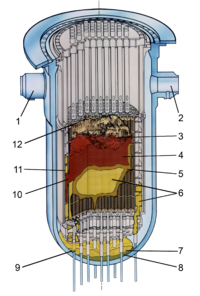
Photo from wikipedia
Abstract Laser solid forming employing a paraxial powder-feeding system was developed to repair gas-turbine hot-section components composed of the non-weldable nickel-based superalloy K447A. In the present study, hot isostatic pressing,… Click to show full abstract
Abstract Laser solid forming employing a paraxial powder-feeding system was developed to repair gas-turbine hot-section components composed of the non-weldable nickel-based superalloy K447A. In the present study, hot isostatic pressing, solid solution, and double-aging heat treatments were applied to research the influence of heat treatments on the forming characteristics, microstructural characteristics, and tensile properties of cladding zones obtained by laser solid forming. The results showed that cladding layers (CLs) without hot cracking or blowholes were obtained after heat treatment. Shrinkage elimination and γʹ precipitate growth were observed, MC-type carbides precipitated from the solidification grain boundary (SGB) and partly transformed into M23C6-type carbides in the CL. The hardness in CLs became uniform and nearly equal to that of the base metal (BM). The strength of the heat-treated half-BM, half-CL (HBC) specimen was nearly equal to that of the heat-treated BM specimen, but the elongation of the HBC specimen was reduced by ∼40%. In the BM side of the HBC specimen, cracks initiated at script-like carbides and extended along the grain boundaries, while in the CL side, cracks extended along the SGB with massive granular carbides, which reduced the elongation of the HBC specimen.
Journal Title: Journal of Alloys and Compounds
Year Published: 2019
Link to full text (if available)
Share on Social Media: Sign Up to like & get
recommendations!